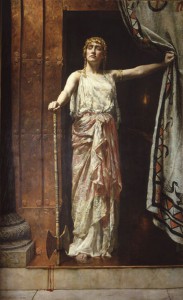
August 12, 2015, by Oliver Thomas
Greek Tragedy on the Small Screen
Lynn Fotheringham previews a series of rarely-seen TV productions of Greek tragedy, which she has organised to be shown in Nottingham next spring.
In January-March 2016, CADRE and Lakeside Arts are bringing the BFI mini-season ‘Classics on TV: Greek Tragedy on the Small Screen’ to Nottingham. These rare productions range in date from 1958 to the last production specially designed for television, in 1990, and star an extraordinary range of famous actors: Diana Rigg, Ian Holm, Patrick Stewart, Fiona Shaw, Helen Mirren, to name a few. They also embody a wide range of approaches to bringing Greek tragedy to a modern audience.
Most Greek tragedies focus on myths involving family-conflict. Our first five screenings deal with the family of Agamemnon in the run-up to and aftermath of the Trojan War. Our first screening (29th January) starts at the beginning of this story, with the 1990 production of Euripides’ Iphigenia at Aulis. King Agamemnon (Roy Marsden), waiting to set out with his fleet for the Trojan War, is told he will only have fair winds if he sacrifices his beloved daughter Iphigenia (Imogen Boorman); Fiona Shaw plays his wife, Clytemnestra. The production is costumed in modern dress but shot on a deliberately stylised studio set.
 The later stages in the story are told in Aeschylus’ Oresteia trilogy, currently enjoying lots of exposure thanks to versions at the Almeida, the Globe and Manchester’s Home Theatre. On 26th February we will be showing The Serpent Son, a 1979 production of the opening play, Agamemnon, in which Agamemnon (Denis Quilley) returns home at the end of the war with his concubine Cassandra (Helen Mirren) to face the wrath of Clytemnestra (Diana Rigg). The astonishing design for this production, which divided the critics, was partly inspired by Minoan art. On 3rd March in the matinee you will be able to catch another Agamemnon, this time Peter Hall’s famous National Theatre version, with an all-male, masked cast; the 1983 television screening was edited together from footage of the stage-performance captured by four cameras. And, even if you miss one of the Agamemnons, you can complete the trilogy with Hall’s Libation-Bearers and Eumenides that evening. In this part of the story the children of Agamemnon and Clytemnestra, Orestes and Electra, avenge their father’s death, but Orestes faces the wrath of the Furies for matricide.
The later stages in the story are told in Aeschylus’ Oresteia trilogy, currently enjoying lots of exposure thanks to versions at the Almeida, the Globe and Manchester’s Home Theatre. On 26th February we will be showing The Serpent Son, a 1979 production of the opening play, Agamemnon, in which Agamemnon (Denis Quilley) returns home at the end of the war with his concubine Cassandra (Helen Mirren) to face the wrath of Clytemnestra (Diana Rigg). The astonishing design for this production, which divided the critics, was partly inspired by Minoan art. On 3rd March in the matinee you will be able to catch another Agamemnon, this time Peter Hall’s famous National Theatre version, with an all-male, masked cast; the 1983 television screening was edited together from footage of the stage-performance captured by four cameras. And, even if you miss one of the Agamemnons, you can complete the trilogy with Hall’s Libation-Bearers and Eumenides that evening. In this part of the story the children of Agamemnon and Clytemnestra, Orestes and Electra, avenge their father’s death, but Orestes faces the wrath of the Furies for matricide.
On 12th March we move back in time in terms of both story and production history. The action of Sopohocles’ Electra corresponds to Aeschylus’ Libation-Bearers, and gives us an unusual opportunity to compare the different playwrights’ handling of the same events. In 1962, a touring production by a Greek theatre company was adapted for television: though it was screened in modern Greek without subtitles, the extraordinary television event captured the imagination of the public. The matinee screening will also include a remarkable 17-minute snippet that is all that survives of the 1958 production of Euripides’ Women of Troy, which tells of the devastation at the end of the Trojan War before Agamemnon’s return home. It stars Catherine Lacey as Queen Hecuba and Rosalie Crutchley as Princess Andromache; a young June Brown (Dot from Eastenders) appears in the chorus.
That evening, our final screening switches to the most dysfunctional royalty of all, with two productions of Sophocles’ Oedipus Tyrannus. In the 1972 King Oedipus, Ian Holm is Oedipus and Sheila Allen his mother Jocasta, in a modern-dress production shot in a realistic but vague post-colonial setting. The 1977 Oedipus Tyrannus (second half only), was made with the Open University for its Drama course, and employs half-masks, elaborate wigs, exotic costumes and a dancing chorus to convey the foreignness of Greek tragedy. Patrick Stewart is Oedipus and Rosalie Crutchley is Jocasta.
As well as the screenings, we will be holding talks, workshops and discussions, and a pop-up exhibition of memorabilia relating to modern productions of Greek tragedy. More details to follow!
Image credits: Top: a 1957 television, (c) Takkk, licensed via Wikimedia Commons. Right: John Collier, ‘Clytemnestra after the murder’ (1882), via Wikimedia Commons.
No comments yet, fill out a comment to be the first

Leave a Reply